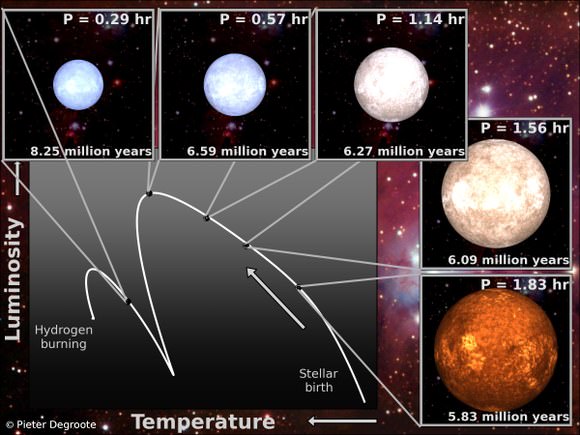Precisely dating a star can have important consequences for understanding stellar evolution and any circling exoplanets. But it’s one of the toughest plights in astronomy with only a few existing techniques.
One method is to find a star with radioactive elements like uranium and thorium, whose half-lives are known and can be used to date the star with certainty. But only about 5 percent of stars are thought to have such a chemical signature.
Another method is to look for a relationship between a star’s age and its ‘metals,’ the astronomer’s slang term for all elements heavier than helium. Throughout cosmic history, the cycle of star birth and death has steadily produced and dispersed more heavy elements leading to new generations of stars that are more heavily seeded with metals than the generation before. But the uncertainties here are huge.
The latest research is providing a new technique, showing that protostars can easily be dated by measuring the acoustic vibrations — sound waves — they emit.
Stars are born deep inside giant molecular clouds of gas. Turbulence within these clouds gives rise to pockets of gas and dust with enough mass to collapse under their own gravitational contraction. As each cloud — protostar — continues to collapse, the core gets hotter, until the temperature is sufficient enough to begin nuclear fusion, and a full-blown star is born.
Our Sun likely required about 50 million years to mature from the beginning of collapse.
Theoretical physicists have long posited that protostars vibrate differently than stars. Now, Konstanze Zwintz from KU Leuven’s Institute for Astronomy, and colleagues have tested this prediction.
The team studied the vibrations of 34 protostars in NGC 2264, all of which are less than 10 million years old. They used the Canadian MOST satellite, the European CoRoT satellite, and ground-based facilities such as the European Southern Observatory in Chile.
“Our data show that the youngest stars vibrate slower while the stars nearer to adulthood vibrate faster,” said Zwintz in a press release. “A star’s mass has a major impact on its development: stars with a smaller mass evolve slower. Heavy stars grow faster and age more quickly.”
Each stars’ vibrations are indirectly seen by their subtle changes in brightness. Bubbles of hot, bright gas rise to the star’s surface and then cool, dim, and sink in a convective loop. This overturn causes small changes in the star’s brightness, revealing hidden information about the sound waves deep within.
You can actually hear this process when the stellar light curves are converted into sound waves. Below is a video of such singing stars, produced by Nature last year.
“We now have a model that more precisely measures the age of young stars,” said Zwintz. “And we are now also able to subdivide young stars according to their various life phases.”
The results were published in Science.


You’ve heard of data visualisation this is audiblisation. I wonder, can a person detect the change in tone of a planetary transit?
This is very cool and important work. Thanks for bringing this to our attention. Leuven is a provincial capital in the flemish region of Belgium. I look forward to reading their paper and also learning more about their great university.